IL-6-dependent PGE2 secretion by mesenchymal stem cells inhibits local inflammation in experimental arthritis
- PMID: 21151872
- PMCID: PMC2998425
- DOI: 10.1371/journal.pone.0014247
IL-6-dependent PGE2 secretion by mesenchymal stem cells inhibits local inflammation in experimental arthritis
Abstract
Background: Based on their capacity to suppress immune responses, multipotent mesenchymal stromal cells (MSC) are intensively studied for various clinical applications. Although it has been shown in vitro that the immunomodulatory effect of MSCs mainly occurs through the secretion of soluble mediators, the mechanism is still not completely understood. The aim of the present study was to better understand the mechanisms underlying the suppressive effect of MSCs in vivo, using cells isolated from mice deficient in the production of inducible nitric oxide synthase (iNOS) or interleukin (IL)-6 in the murine model of collagen-induced arthritis.
Principal findings: In the present study, we show that primary murine MSCs from various strains of mice or isolated from mice deficient for iNOS or IL-6 exhibit different immunosuppressive potential. The immunomodulatory function of MSCs was mainly attributed to IL-6-dependent secretion of prostaglandin E2 (PGE2) with a minor role for NO. To address the role of these molecules in vivo, we used the collagen-induced arthritis as an experimental model of immune-mediated disorder. MSCs effectively inhibited collagen-induced inflammation during a narrow therapeutic window. In contrast to wild type MSCs, IL-6-deficient MSCs and to a lesser extent iNOS-deficient MSCs were not able to reduce the clinical signs of arthritis. Finally, we show that, independently of NO or IL-6 secretion or Treg cell induction, MSCs modulate the host response by inducing a switch to a Th2 immune response.
Significance: Our data indicate that mscs mediate their immunosuppressive effect via two modes of action: locally, they reduce inflammation through the secretion of anti-proliferative mediators, such as NO and mainly PGE2, and systemically they switch the host response from a Th1/Th17 towards a Th2 immune profile.
Conflict of interest statement
Figures
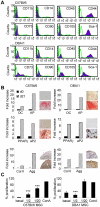
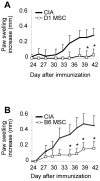
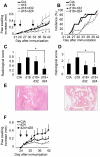
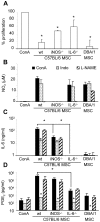
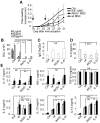
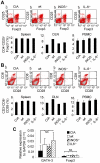
Similar articles
-
Preconditioning of bone marrow-derived mesenchymal stem cells highly strengthens their potential to promote IL-6-dependent M2b polarization.Stem Cell Res Ther. 2018 Oct 25;9(1):286. doi: 10.1186/s13287-018-1039-2. Stem Cell Res Ther. 2018. PMID: 30359316 Free PMC article.
-
IL-17 down-regulates the immunosuppressive capacity of olfactory ecto-mesenchymal stem cells in murine collagen-induced arthritis.Oncotarget. 2016 Jul 12;7(28):42953-42962. doi: 10.18632/oncotarget.10261. Oncotarget. 2016. PMID: 27356747 Free PMC article.
-
Flk-1+ mesenchymal stem cells aggravate collagen-induced arthritis by up-regulating interleukin-6.Clin Exp Immunol. 2010 Mar;159(3):292-302. doi: 10.1111/j.1365-2249.2009.04069.x. Epub 2009 Dec 4. Clin Exp Immunol. 2010. PMID: 20002448 Free PMC article.
-
Pathological role of inflammation in ocular disease progress and its targeting by mesenchymal stem cells (MSCs) and their exosome; current status and prospect.Pathol Res Pract. 2023 Aug;248:154619. doi: 10.1016/j.prp.2023.154619. Epub 2023 Jun 12. Pathol Res Pract. 2023. PMID: 37406377 Review.
-
Evaluation of the Therapeutic Potential of Mesenchymal Stem Cells (MSCs) in Preclinical Models of Autoimmune Diseases.Stem Cells Int. 2022 Jul 28;2022:6379161. doi: 10.1155/2022/6379161. eCollection 2022. Stem Cells Int. 2022. PMID: 35935180 Free PMC article. Review.
Cited by
-
Human embryonic stem cell-derived mesenchymal stromal cells ameliorate collagen-induced arthritis by inducing host-derived indoleamine 2,3 dioxygenase.Arthritis Res Ther. 2016 Apr 1;18:77. doi: 10.1186/s13075-016-0979-0. Arthritis Res Ther. 2016. PMID: 27036118 Free PMC article.
-
Multipotent Mesenchymal Stromal Cells in Rheumatoid Arthritis and Systemic Lupus Erythematosus; From a Leading Role in Pathogenesis to Potential Therapeutic Saviors?Front Immunol. 2021 Feb 24;12:643170. doi: 10.3389/fimmu.2021.643170. eCollection 2021. Front Immunol. 2021. PMID: 33732263 Free PMC article. Review.
-
MANF Produced by MRL Mouse-Derived Mesenchymal Stem Cells Is Pro-regenerative and Protects From Osteoarthritis.Front Cell Dev Biol. 2021 Mar 2;9:579951. doi: 10.3389/fcell.2021.579951. eCollection 2021. Front Cell Dev Biol. 2021. PMID: 33738280 Free PMC article.
-
Fibrosis Development in HOCl-Induced Systemic Sclerosis: A Multistage Process Hampered by Mesenchymal Stem Cells.Front Immunol. 2018 Nov 5;9:2571. doi: 10.3389/fimmu.2018.02571. eCollection 2018. Front Immunol. 2018. PMID: 30455706 Free PMC article.
-
Mesenchymal stem cell repression of Th17 cells is triggered by mitochondrial transfer.Stem Cell Res Ther. 2019 Aug 1;10(1):232. doi: 10.1186/s13287-019-1307-9. Stem Cell Res Ther. 2019. PMID: 31370879 Free PMC article.
References
-
- Vinatier C, Mrugala D, Jorgensen C, Guicheux J, Noel D. Cartilage engineering: a crucial combination of cells, biomaterials and biofactors. Trends Biotechnol. 2009;27:307–314. - PubMed
-
- Djouad F, Bouffi C, Ghannam S, Noel D, Jorgensen C. Mesenchymal stem cells: innovative therapeutic tools for rheumatic diseases. Nat Rev Rheumatol. 2009;5:392–399. - PubMed
-
- Spaggiari GM, Capobianco A, Abdelrazik H, Becchetti F, Mingari MC, et al. Mesenchymal stem cells inhibit natural killer-cell proliferation, cytotoxicity, and cytokine production: role of indoleamine 2,3-dioxygenase and prostaglandin E2. Blood. 2008;111:1327–1333. - PubMed
-
- Sato K, Ozaki K, Oh I, Meguro A, Hatanaka K, et al. Nitric oxide plays a critical role in suppression of T-cell proliferation by mesenchymal stem cells. Blood. 2007;109:228–234. - PubMed
-
- Ren G, Zhang L, Zhao X, Xu G, Zhang Y, et al. Mesenchymal stem cell-mediated immunosuppression occurs via concerted action of chemokines and nitric oxide. Cell Stem Cell. 2008;2:141–150. - PubMed
Publication types
MeSH terms
Substances
LinkOut - more resources
Full Text Sources
Other Literature Sources

